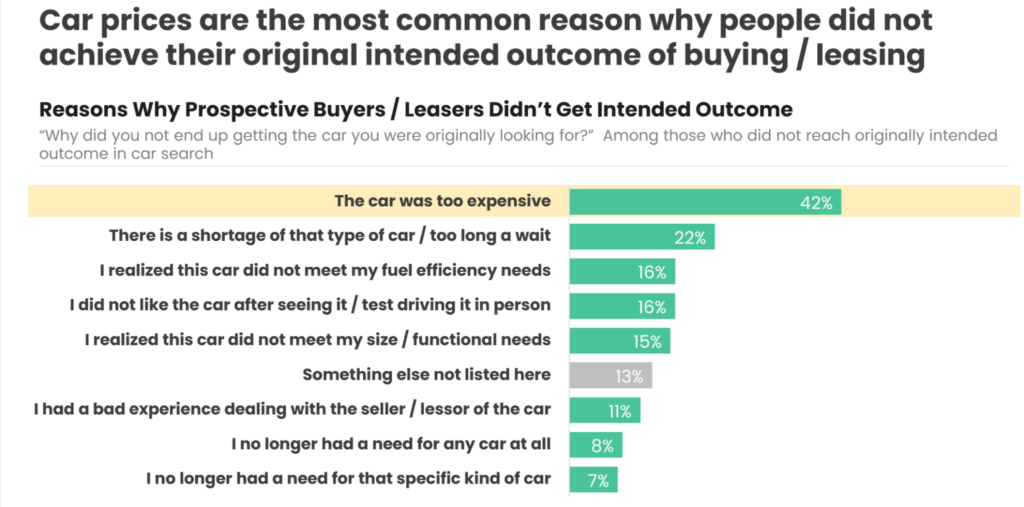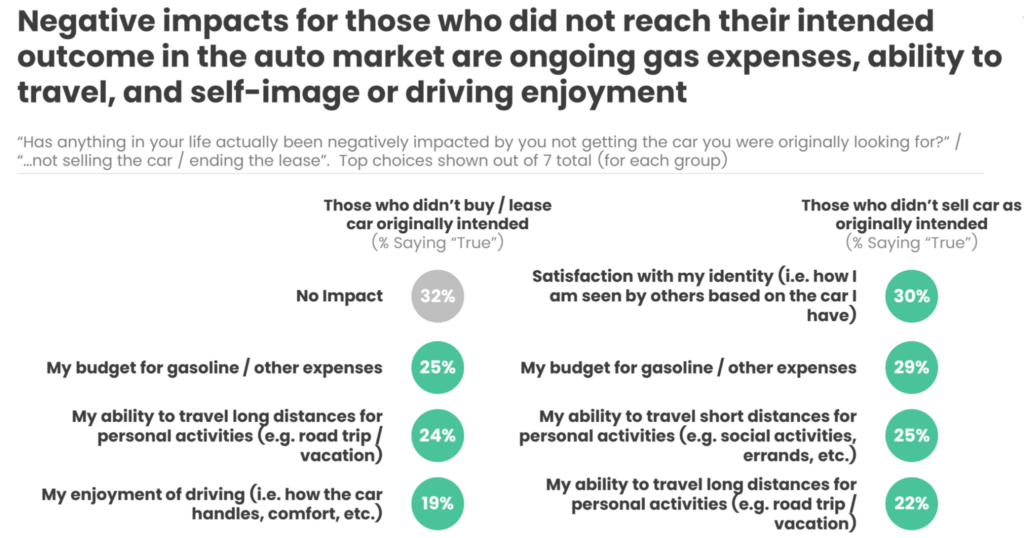What Automotive OEMs & Dealers Can Do to Improve Customer Experience During High Inflation
August 26, 2022
Market Research
External forces are disrupting the customer experience in the automotive industry. Find out what OEMs and dealers can do to improve the experience for customers.
Between high prices and low inventory, it’s not a great time to be buying — or leasing — a car in the U.S. It’s increasingly harder to afford a car and pay off the loan, especially for younger consumers.
Most customers aren’t ending up with the vehicle they originally set out to bring home, a reality that’s having adverse effects on other aspects of consumers’ daily lives, according to new findings from Medallia’s Market Research division, including a Sense360 by Medallia survey of 2,220 consumers, a Sense360 by Medallia analysis of the credit and debit transactions of 5M+ US consumers, and a LivingLens by Medallia video survey of auto shoppers.
The State of the American Car Market in 2022
Medallia’s researchers set out to find out how external factors, including inflation and supply chain delays, are impacting the customer experience in the U.S. automotive industry. Here are the four key takeaways from our analysis that leadership at dealers and OEMs need to be aware of.
1. The majority of car seekers aren’t ending up with the type of vehicle they want to buy or lease.
Of all consumers looking to buy or lease a car, only 23% say they’ve successfully found the car they’re looking for.
2. Cost is the biggest reason why prospective car leasers and buyers aren’t moving forward with the vehicle they originally wanted to buy or lease.
More than 4 in 10 (42%) say the car they originally wanted was “too expensive.” Other top issues that are preventing consumers from driving away with the ride of their choice include shortages and wait times, the vehicles not meeting their expectations in general and, more specifically, fuel efficiency needs and size.
3. Most consumers (68%) say that not being able to buy or lease the car they originally had in mind is having a negative impact on their daily lives.
Not being able to purchase or lease their preferred vehicle is impacting consumers’ budgets for gas and other expenses, limiting their ability to travel for personal activities — such as for a vacation — and lowering their overall satisfaction with driving.
4. The majority of customers say they had a negative experience when buying or leasing a car.
In addition to facing supply shortages and higher prices, customers surveyed via LivingLens by Medallia’s video survey capabilities have expressed frustration with poor and slow in-person service at dealerships, parts shortages for those buying used cars they plan to repair, and delays with financial processes, including the loan approval process and insurance repayments for car replacements.
Why Experience Management Works, Even in Hard Times
Prioritizing experience management in the automotive industry can help brands better understand and meet customer wants and needs to drive financial growth, no matter the state of the economy.
As part of our Medallia Institute report, Uncovering the Secrets Behind a Successful Customer Experience Program, based on a study of more than 580 customer experience programs, we discovered that companies with successful customer experience programs have a few key factors in common. Our researchers found that organizations that are customer experience leaders are:
- 2.5x more likely to have enough data to understand the experience of customers in key segments, compared with customer experience laggards
- 3.5x more likely to democratize customer experience data among their employees and empower them to use these insights as a foundation for decision-making across business units
- 61% more likely to invest in improving the employee experience to deliver even better customer experiences
Similarly, as part of our Medallia Institute report, Employee Experience Excellence: Key Practices that Differentiate Leaders from Laggards, based on a study of more than 650 HR professionals, we found that companies with leading employee experience programs are more likely to:
- Get feedback from their employees frequently and comprehensively — employee experience leaders are 3.5 times more likely to obtain employee feedback at least monthly, if not more frequently
- Make employee experience part of their strategy — 49% of leaders have employee experience goals throughout the organization vs. 9% of laggards
- Involve the entire organization in employee experience initiatives — 72% of EX leaders indicate that direct team leaders and people managers are highly involved in the organization’s employee experience initiatives, but only 18% of laggards say the same
Successful Experience Management in Action
Leading luxury automaker Mercedes-Benz recognizes that ensuring exceptional customer experiences is central to fostering customer loyalty and retention at the dealership and brand levels. That’s why the company decided to invest in building out a comprehensive customer experience management program.
Since partnering with Medallia on these efforts, Mercedes-Benz now has the technology in place to collect real-time customer feedback about experiences with purchasing, leasing, and vehicle servicing and has democratized access to these insights across 360 dealerships and more than 5,000 employees. As a result, team members are able to optimize experiences in the moment, a competitive advantage that’s helped Mercedes-Benz strengthen NPS for both service and sales.
Given the degree to which external forces are having a negative impact on the customer experience in the automotive industry, it’s all the more important that dealers and OEMs put experience management best practices into place to maximize customer satisfaction in areas where these brands have some influence.
Next Steps to Earning More Customer Loyalty
It’s not an easy time to be managing customer experiences in the automotive industry, but OEMs and dealers with advanced employee and customer experience programs can get ahead of customer challenges and find ways to maximize satisfaction and loyalty, even in the face of uncertainty.
As Medallia’s customer experience experts explain in our guide How to Launch a Customer Experience Program, companies with successful customer experience programs are evolving beyond relying on reactive customer experience tactics and are instead adopting proactive customer experience strategies, using the data from their customer experience programs to create predictive analytics frameworks, to forecast which efforts will have positive CX impacts, as well as prescriptive analytics frameworks, to prescribe next best actions to improve the customer experience.
For more ways to improve your employee and customer experience efforts to strengthen customer satisfaction even during challenging times, check out our guide, Lessons From Luxury: How Automotive & Recreational Vehicle Brands Can Create Exceptional Customer Experiences That Build Loyalty










